Picture yourself in a favourite holiday location, a memorable urban landscape, or a tranquil viewpoint near your home. It might be somewhere that triggers happy memories. Or a place that pulls your heartstrings, as you remember an important event associated with it. Maybe this landscape makes you feel grounded and connected with the earth. You recall the roughness of the rocks and the shimmering sea, the sunlight filtering through the trees, or the distant hills disappearing into the mist.
We often have strong connections with places that have special meaning to us. But how can we translate that emotional connection into textile art?
In this article, you’ll discover the work of five top textile artists who specialise in landscape-inspired art. Victoria Rose Richards, Claire Benn, Jan Kilpatrick, Artemis and Jette Clover generously share their processes and give us an insight into their work. You’ll also discover some useful tips on how to capture the true character or atmosphere of a landscape.
You’ll find out what attracts them to their subject and what they aim to achieve through their work, whether it is making a record of a special place, capturing a feeling or atmosphere, or expressing a deep connection with nature. These artists represent landscapes using a variety of techniques, including collage, thread painting, hoop art, machine stitch, hand stitch, printing and dyeing. And you’ll see works of all sizes, ranging from the diminutive perfection of small scale works to big and bold statements. Read on to discover more about representing landscapes in textile art.
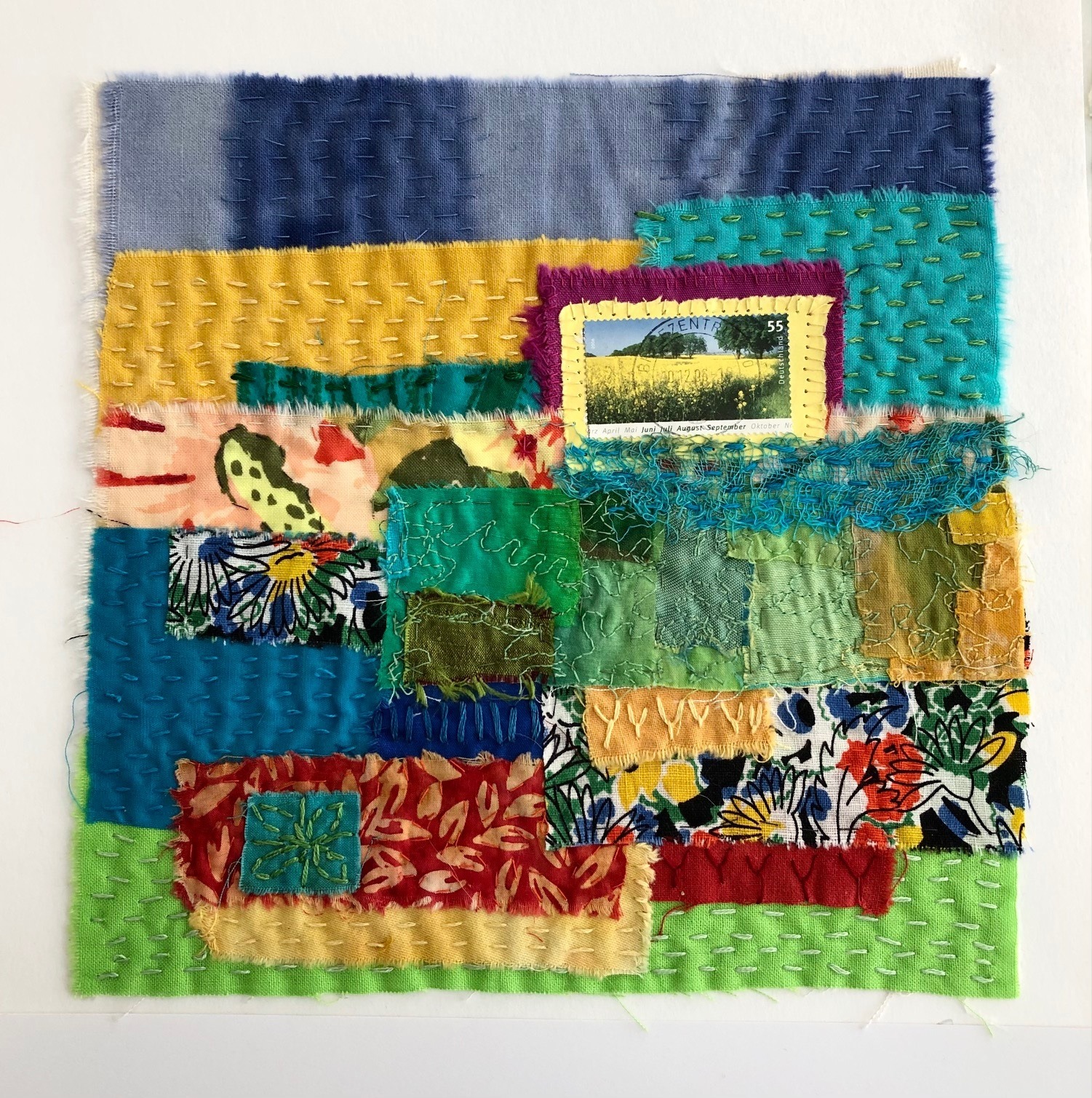
Jette Clover
Belgium-based artist Jette Clover combines textile collage with surface design techniques, including dyeing, painting and printing. Her background as a journalist has given her a penchant for words and paper, both of which often feature in her work. She enjoys the tactile qualities of working with textiles and hand stitch, using careful consideration of colour and lots of layering to express of the atmosphere of a landscape.
Website: www.jetteclover.com
Instagram: @jetteclover
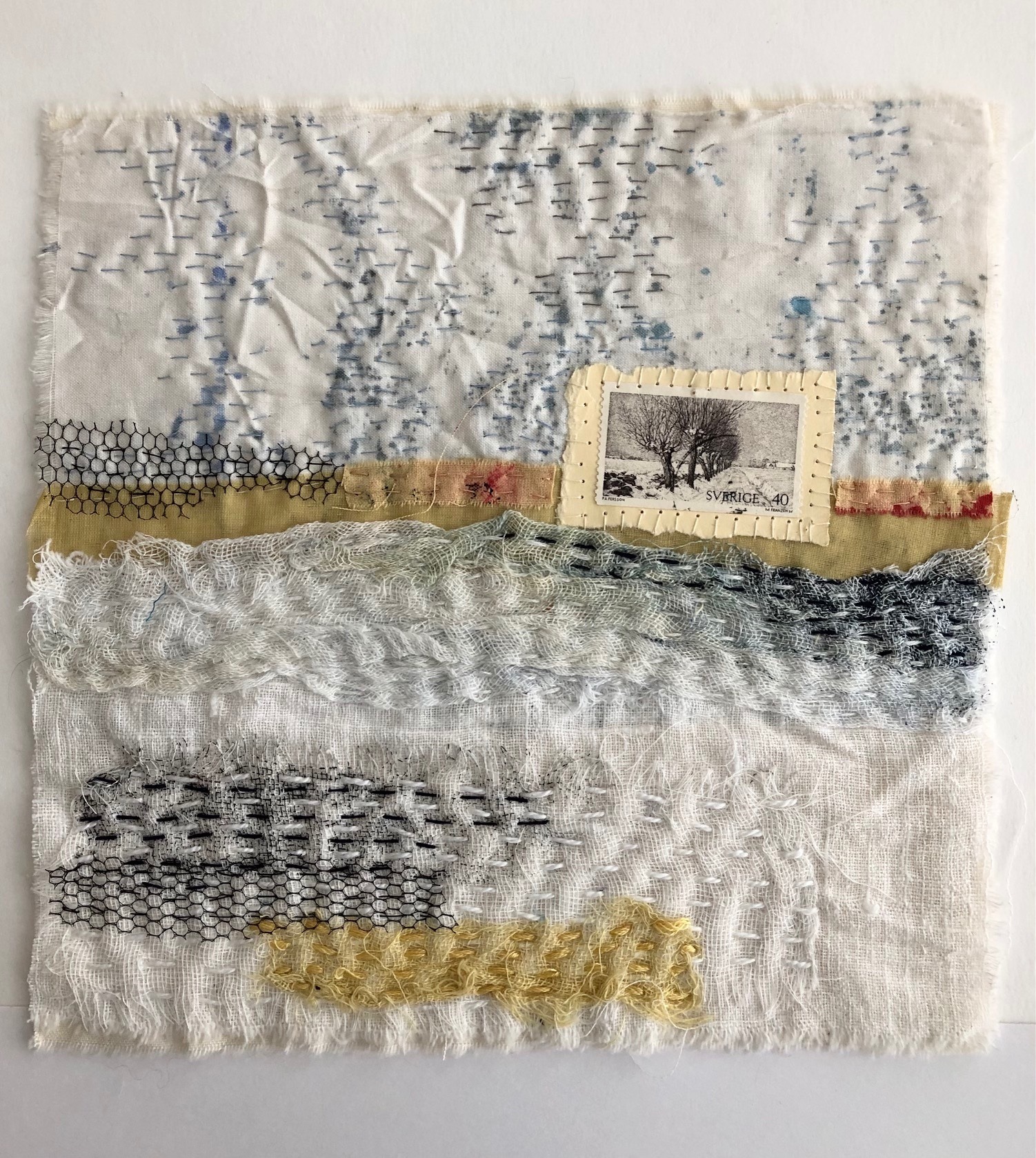
The feeling of home
Jette Clover: I think we are all very influenced by our environment, not only the colours, the light, the shapes and the textures, but also culturally and historically. It is what is ‘home’, whether rural or urban, mountains or seashore.
I don’t use an actual landscape as my source of inspiration. I am more interested in the atmosphere, the feeling. And I don’t make big landscapes. My association with landscape is intimacy, working in a small scale and stitching by hand.
I love subtle, muted colours and a palette of white, grey and black. I am sure this comes from growing up in the misty, grey light of Danish winters, even if I haven’t lived there for many years. The ‘feeling’ for a landscape can also come from the seasons, the time of day, or from the memory of places I have visited, for example my travels in Australia.
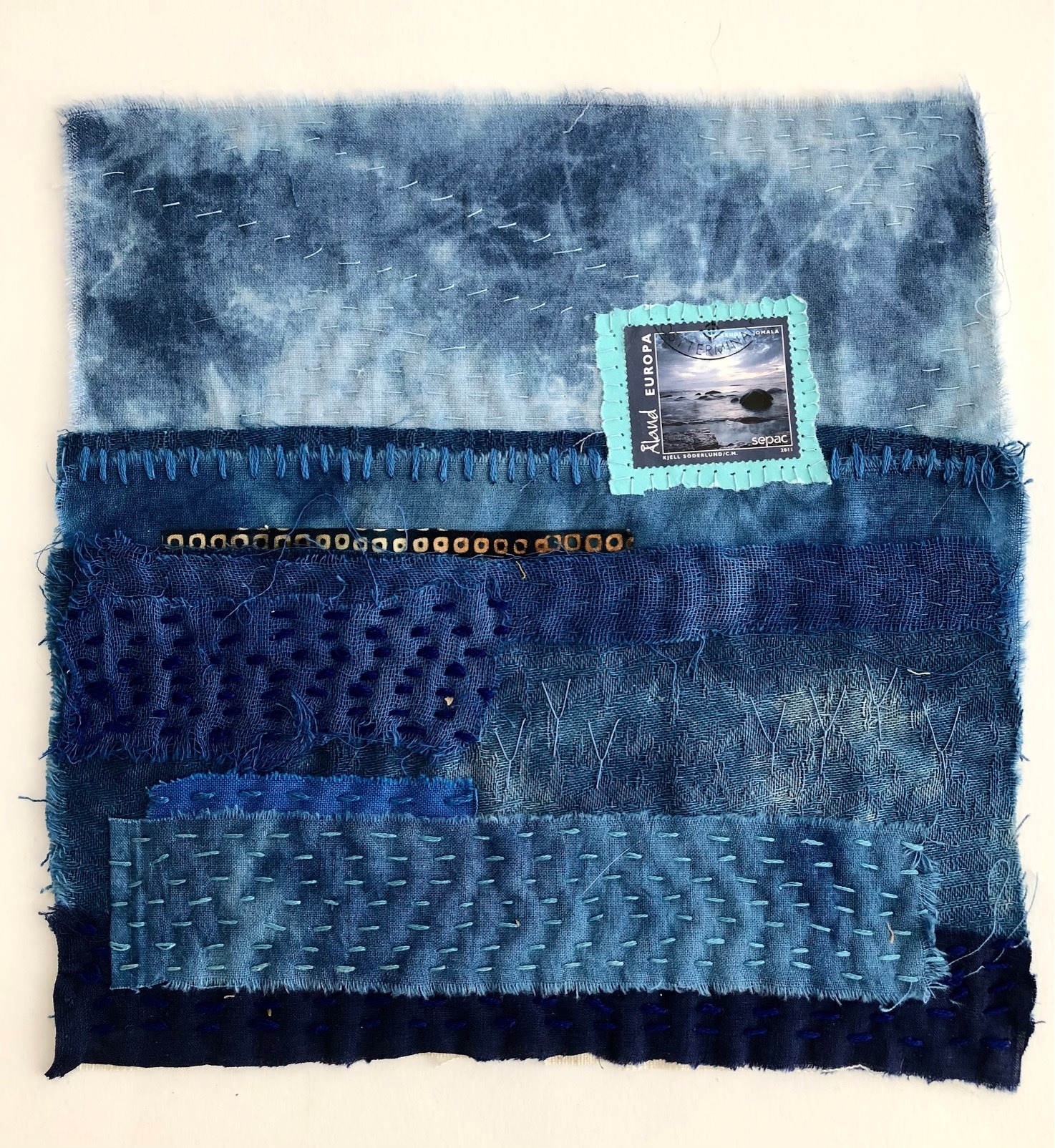
Marks and layers
I am a hands-on person and I construct my quilts as collage. I usually combine cotton, linen, cheese cloth and paper, and I apply mark-making techniques such as painting, discharge, frottage, rusting, screen printing and transfers.
Collage is the ideal medium for me, particularly the layering, experimentation and being tactile. It’s about having the material in your hands and moving it around, until your gut feeling tells you it is right.
I like raw edges and a certain amount of fraying and unravelling. My favourite stitch is the running stitch; it serves as a functional element holding the fabric pieces together and it acts as a graphic mark-making technique. Sometimes I’ll use the buttonhole stitch, the satin stitch and the seed stitch for texture.
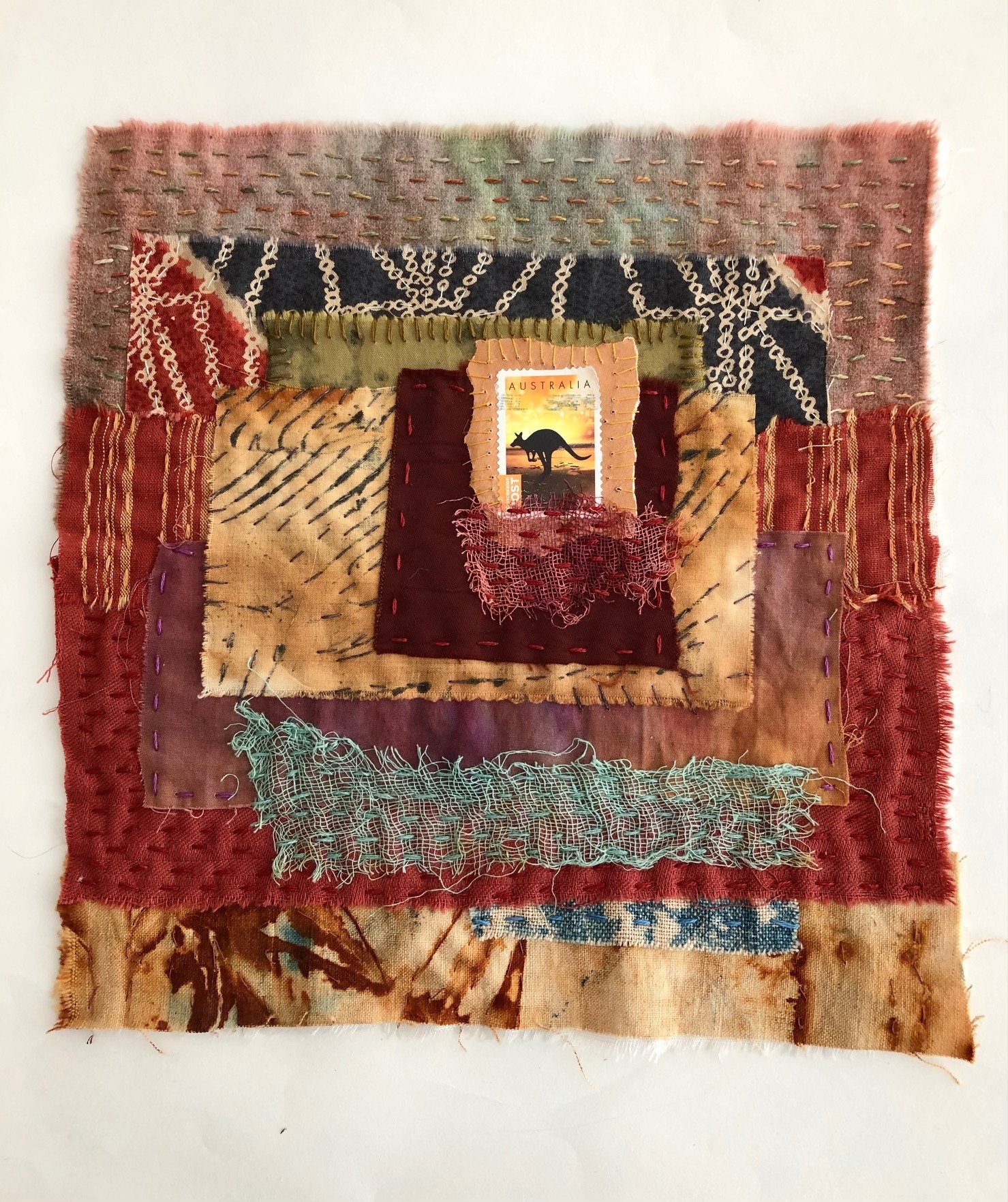
Brainstorming and the work ethic
I think the creative process relies on brainstorming; letting one thought connect to the next and noting down all the ideas that come to mind, without making comment on their relative worth. I use a work book, where I write a lot, collect images, ideas, drawings, and photos, just so that I won’t forget.
But the most important thing for me is to work every day, even if it is only for a short time. The continuity of involvement is essential. Your composition muscle needs to be used. Don’t wait for inspiration. Work a lot!
The American artist Chuck Close said it beautifully:
“Inspiration is for amateurs. The rest of us just show up and get to work. If you wait around for the clouds to part and a bolt of lightening to strike you in the brain, you are not going to make an awful lot of work. All the best ideas come out of the process; they come out of the work itself.”
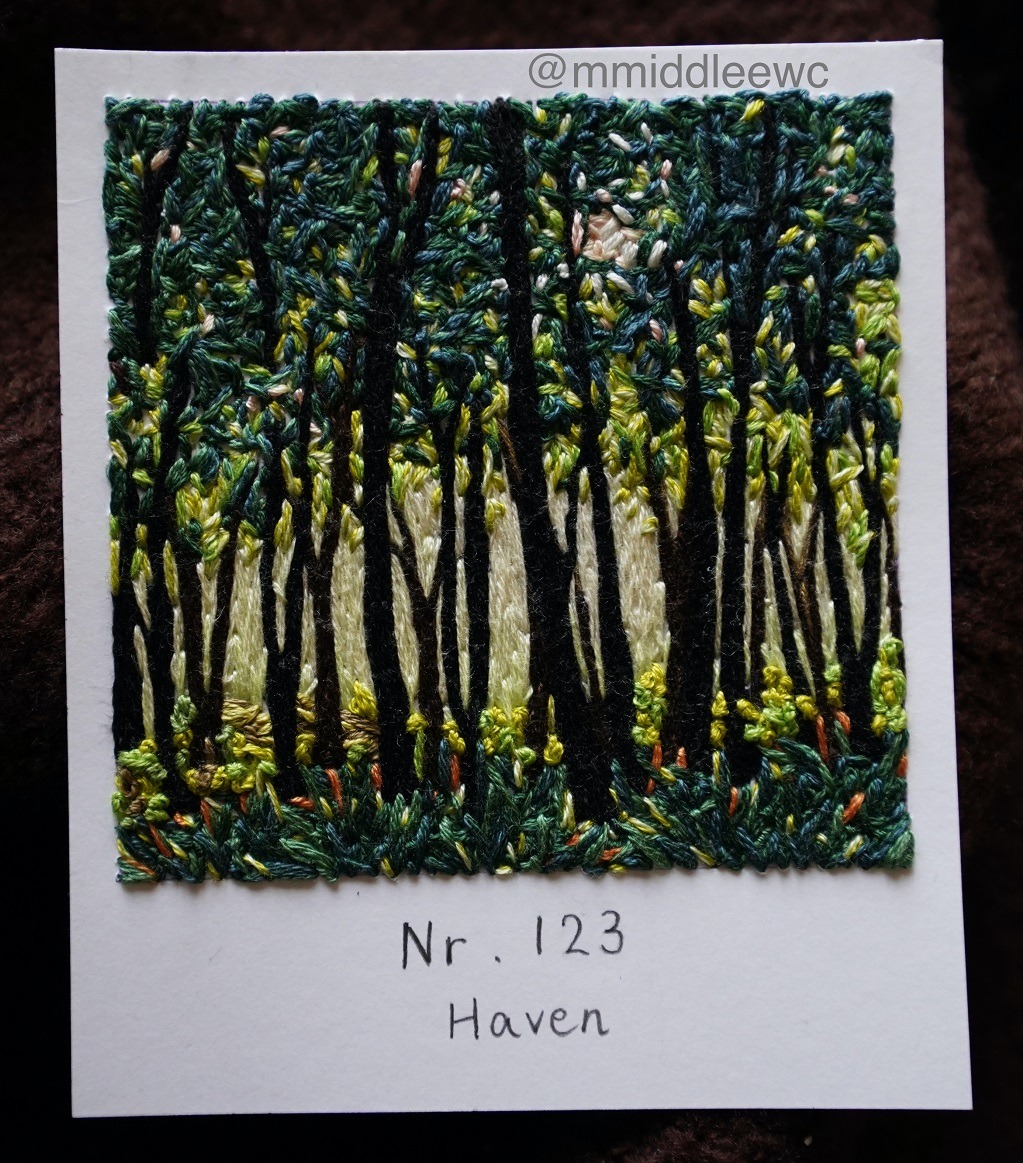
Artemis
Artemis, a stitch artist based in Hong Kong, creates the most delightful impressionistic thread paintings and Polaroid-style embroideries, depicting perfect snapshots of imagined views inspired by local walks in the countryside. Making the most of the slow and tactile nature of hand stitch, each work tells a story.
Instagram: @mmiddleewc
Etsy: https://etsy.com/shop/mmiddleewc
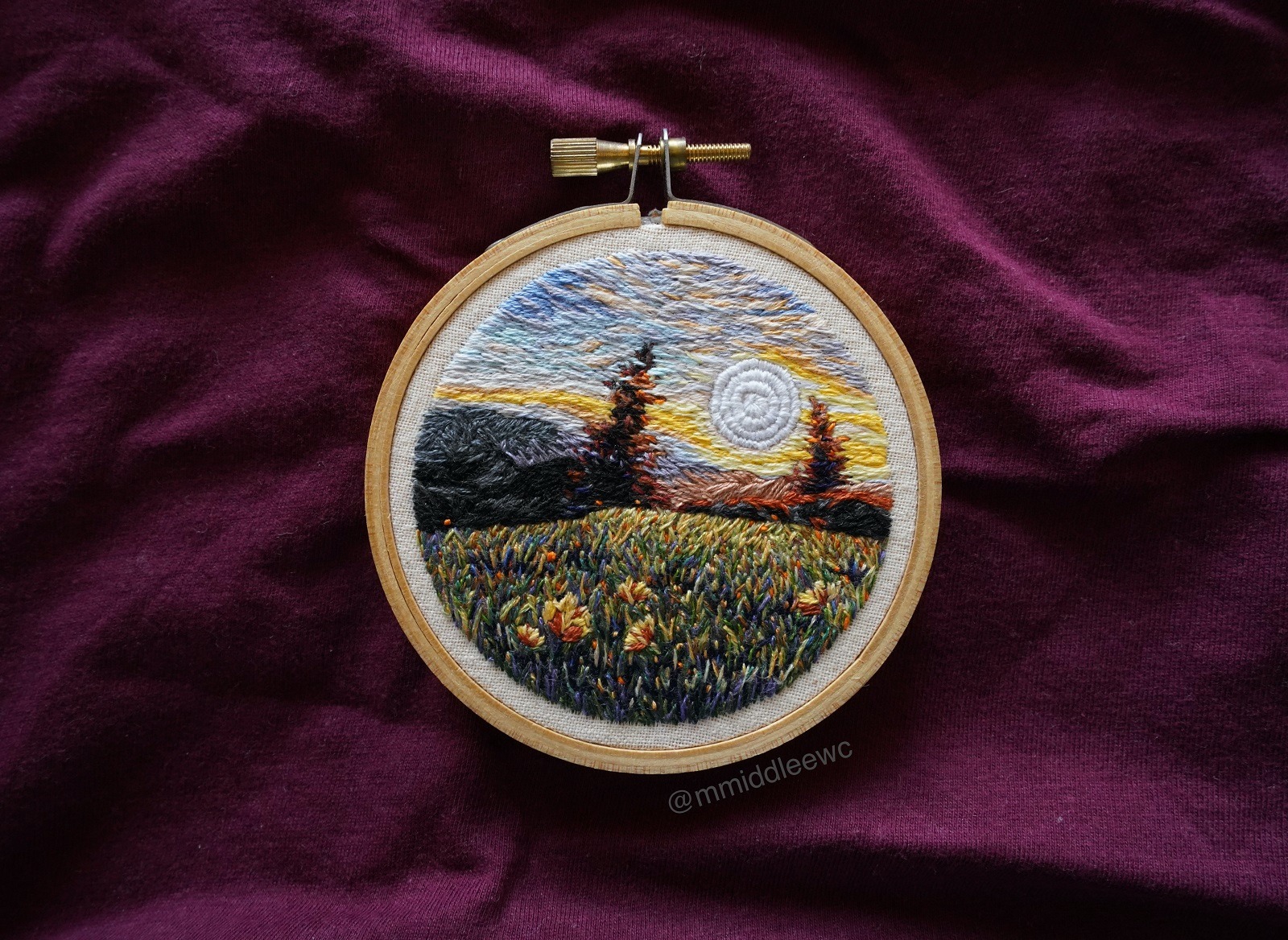
Nature lover
Artemis: I love nature! If I am not working in my cozy room, I am probably out in the wild. When I discovered embroidery I immediately knew I wanted to thread paint landscapes. Embroidery is a slow art, something never to be rushed. I love how you can touch and feel the textures and the threads in your hands.
The creative process allows me to pause and admire the beauty of our mother earth. I don’t set out to limit myself, and I try not to go for a particular style. What I aim to do is to capture the little things in life. Each of my works tells a story, either a memory or a dream.

Catching the vibes
I get inspiration from nature. Mostly I find that ideas pop into my mind while I am hiking or kayaking. I will take reference photos if necessary, but most importantly it is the vibes that motivate me. If I am in the mood to make stitched art, I will sort out the colour palette and briefly list out the embroidery techniques that I am going to use. I’ll outline my idea with a pencil and start! The rest is just improvised, as the whim takes me.

Observation skills
If you are looking for tips for capturing the character of a landscape, I reckon you have to be very clear on what you want to achieve, right from the beginning. If you are going for realism, you might have to stitch with fine threads, fewer texture twists, and have a precise colour selection. If texture is your priority, you can try bold stitching. Play with different embroidery techniques so they enhance each part of your piece and create layers. But you have to be careful not to overdo it, which I always do…!
Observation is the key; the sky is not always blue and clouds are not always white. If embroidering landscapes makes you happy, don’t give up on it! Even though you may not be happy with the outcome, each time you ‘fail’ the results will get better.
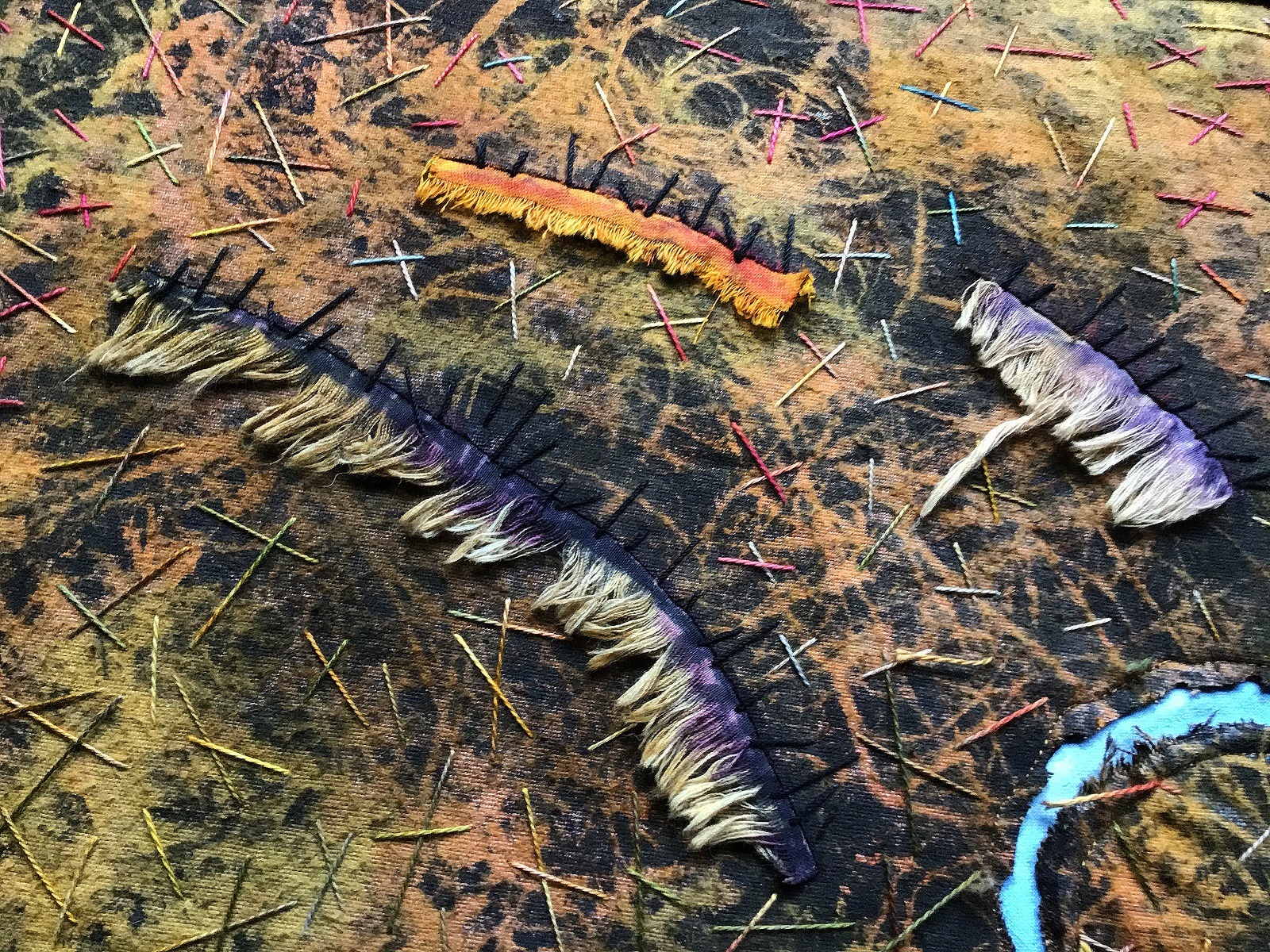
Jan Kilpatrick
Jan Kilpatrick is a textile artist based in Elphin, a tiny crofting township in Assynt, in the North West Highlands of Scotland. It is this wilderness landscape that grounds Jan’s work, providing inspiration for colour, texture and narratives in her printed, stitched and collaged pieces.
Website: www.jankilpatrick.co.uk
Instagram: @jankilpatricktextileartist
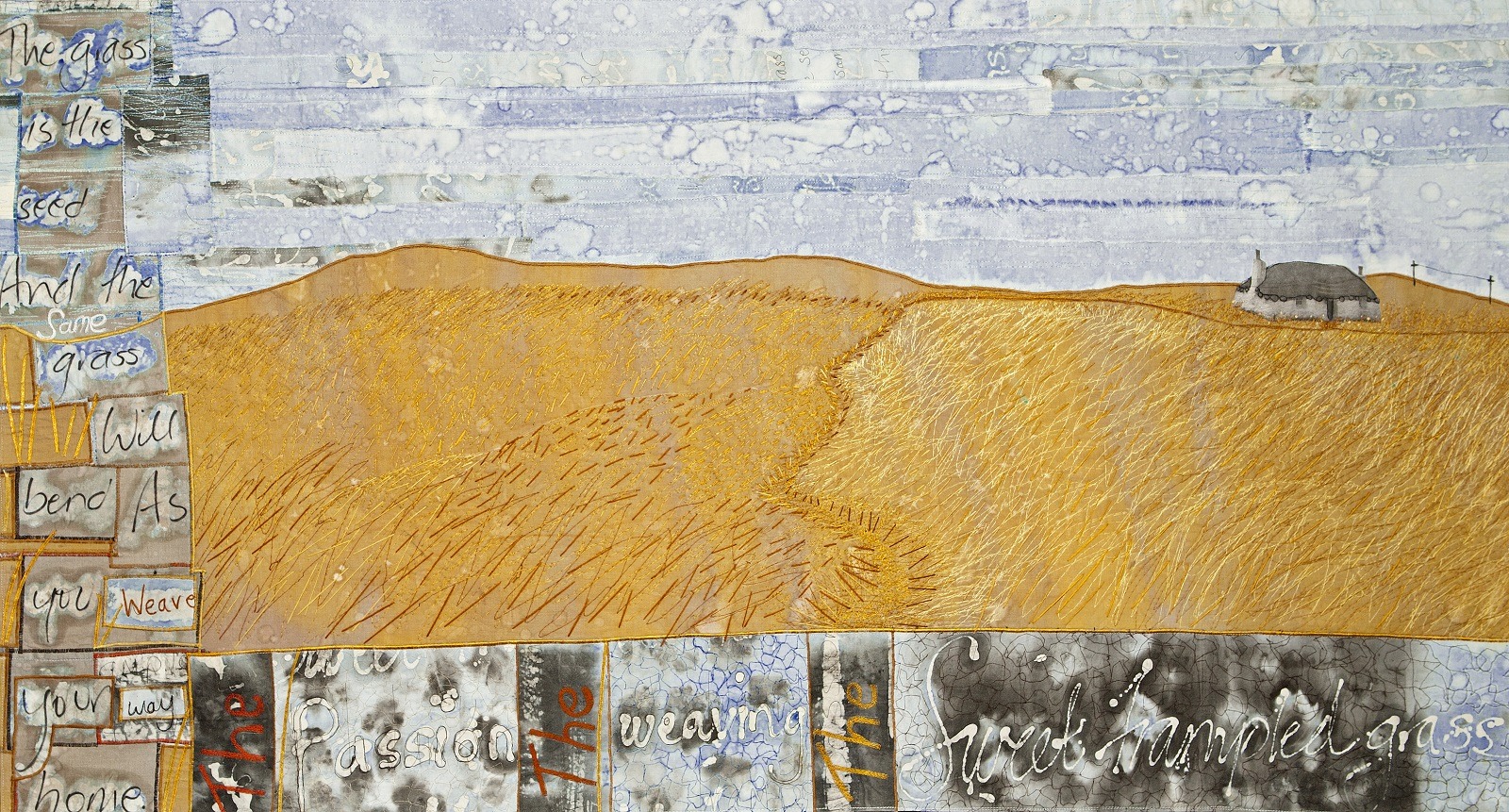
Connecting humanity and nature
Jan Kilpatrick: My work is steeped in the colours and textures of the fabric of this land: its rocks, earth, water, skies and grasses. The imagery I use tells the story of a land with a long and lonely past, and of the modest presence of its human inhabitants.
Often, I present lyrical text within or alongside my work. This combination of image and the written word allows me the fullest expression of the thread, connecting human experience, both ordinary and sacred, with the natural world within which we dwell.
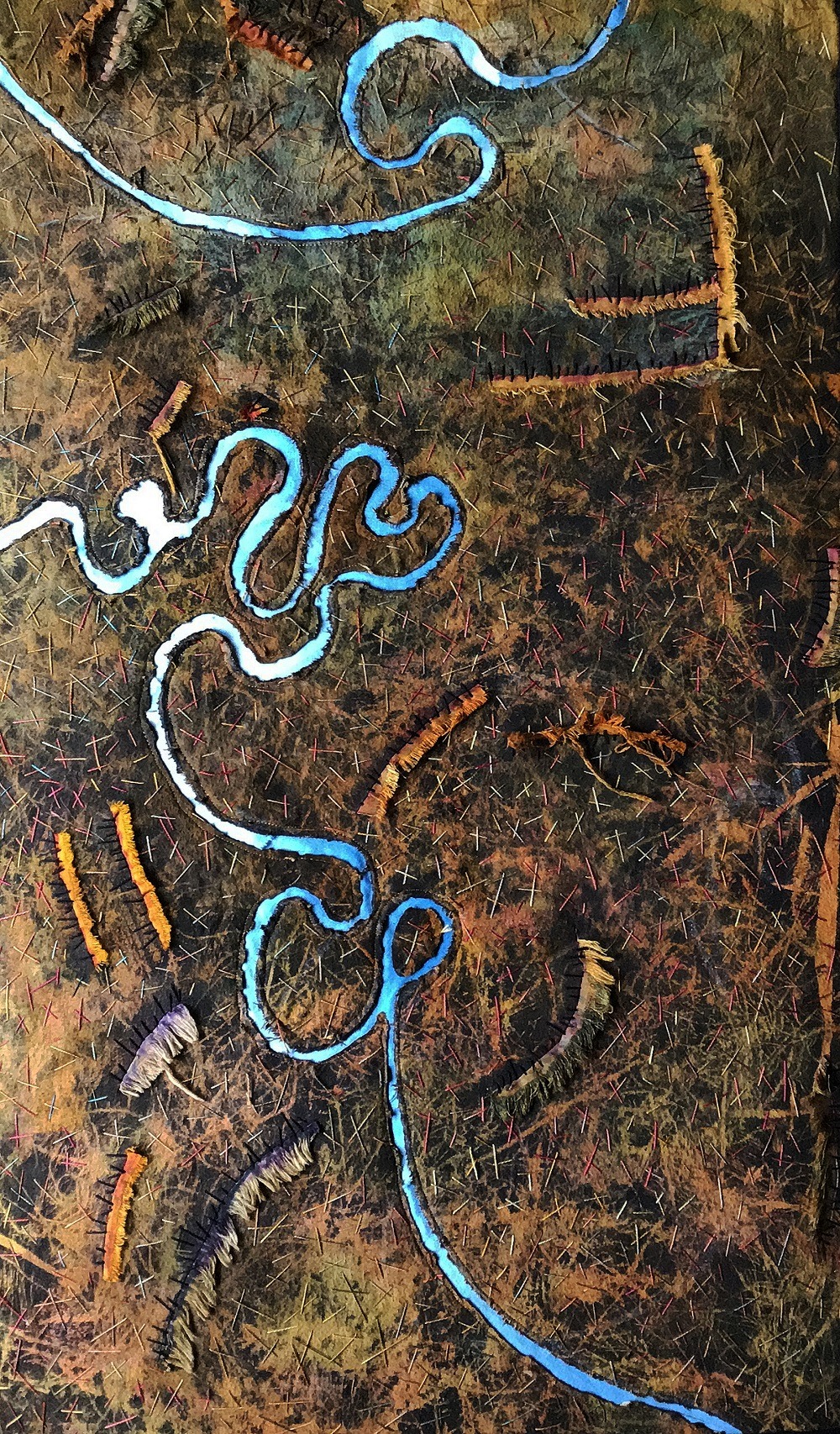
Natural techniques
As I go deeper into the experience of living with this land I find myself drawn towards using more natural pigments, dyes and print-making techniques, such as eco-printing, as the basis for stitching. These processes call for endless experimentation, tempered by just a little on-line research. There is no substitute for making a technique your own, through the use of the materials and work conditions that you have to hand.
I use recycled household cotton and linen fabrics and so the colours and marks achieved on any one piece of cloth can never be exactly replicated. I find this thrilling.
There is usually a collage element to my work, although recently I have become much more interested in intuitively responding to the marks made in the cloth through the dyeing and printing processes, as a basis for repetitive hand stitch. The landscape around my home contains huge tracts of moor, rocky hillsides and puddles of lochans (small lakes), all being features that invite the use of a repetitive mark.
In the past, my initial creative response to the land was expressed through poetry. Nowadays, sometimes the image comes first. Occasionally, I combine the two in the one piece of work. The following words inspired my work “Peat Cuttings”.
Turf
The edge of the moor is black,
the colour of ink
that runs
clear at the fall of my foot.
I look down at tiny
unfathomable colours.
I look up at huge
unfathomable skies.
Then I listen,
eyes closed.
Wind.
Over water.
Running through
this ragged land.
Jan Kilpatrick, Elphin 2017
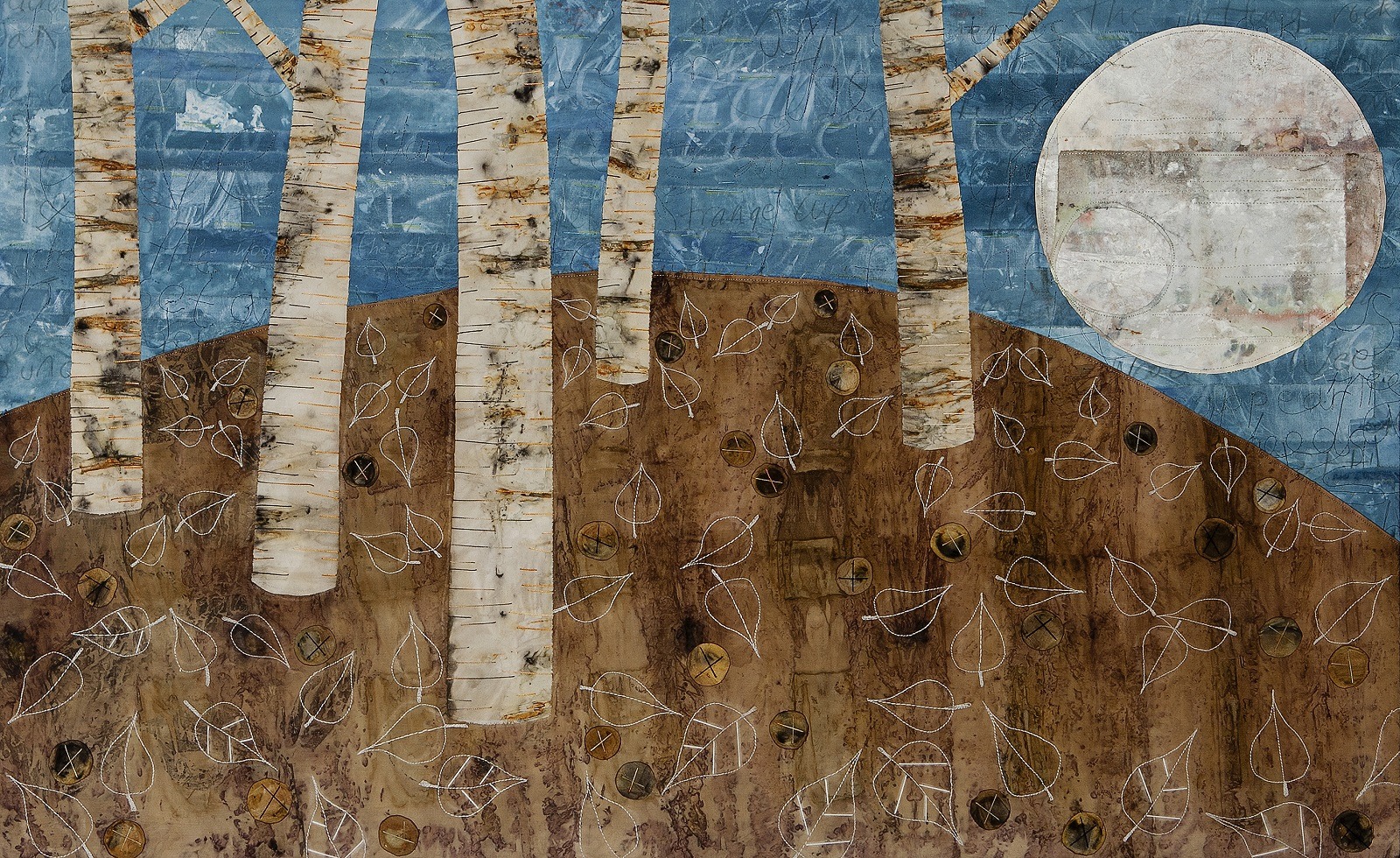
Observation and emotional connection
I find that living and working in the same beautiful location for many years is the key to substance and integrity in my work. I have no art training, so have never fully embraced the practice of drawing. By repeatedly walking and travelling through the same landscape I have been able to internalise it, and so my work is a combination of close observation and a distillation of the key characteristics of the land. I feel part of an ancestral line of memory and have a strong emotional connection to this place.
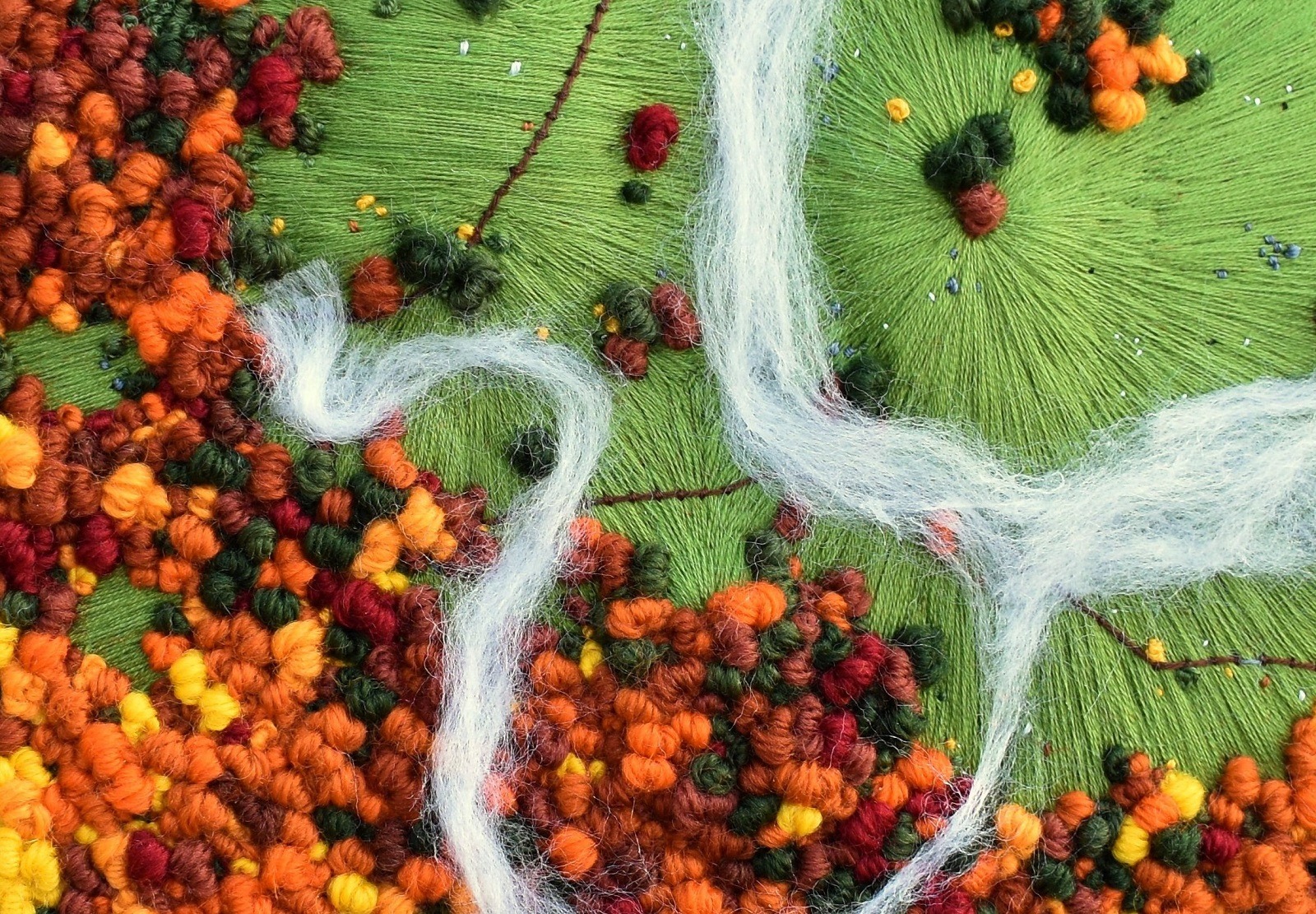
Victoria Rose Richards
Victoria Rose Richards is an embroidery artist based in Devon, UK. She specialises in stitching vibrant aerial views of fields, rivers and trees and meadows. Her artwork is centred around her particular affection for fields, and how they fit together like a countryside jigsaw.
Victoria’s careful attention to detail brings these little worlds to life; she always includes some tiny elements of activity, perhaps some tractor tracks, a few sheep or birds, or a little red car driving down a country lane.
Website: victoriaroserichards.co.uk
Instagram: @victoriaroserichards
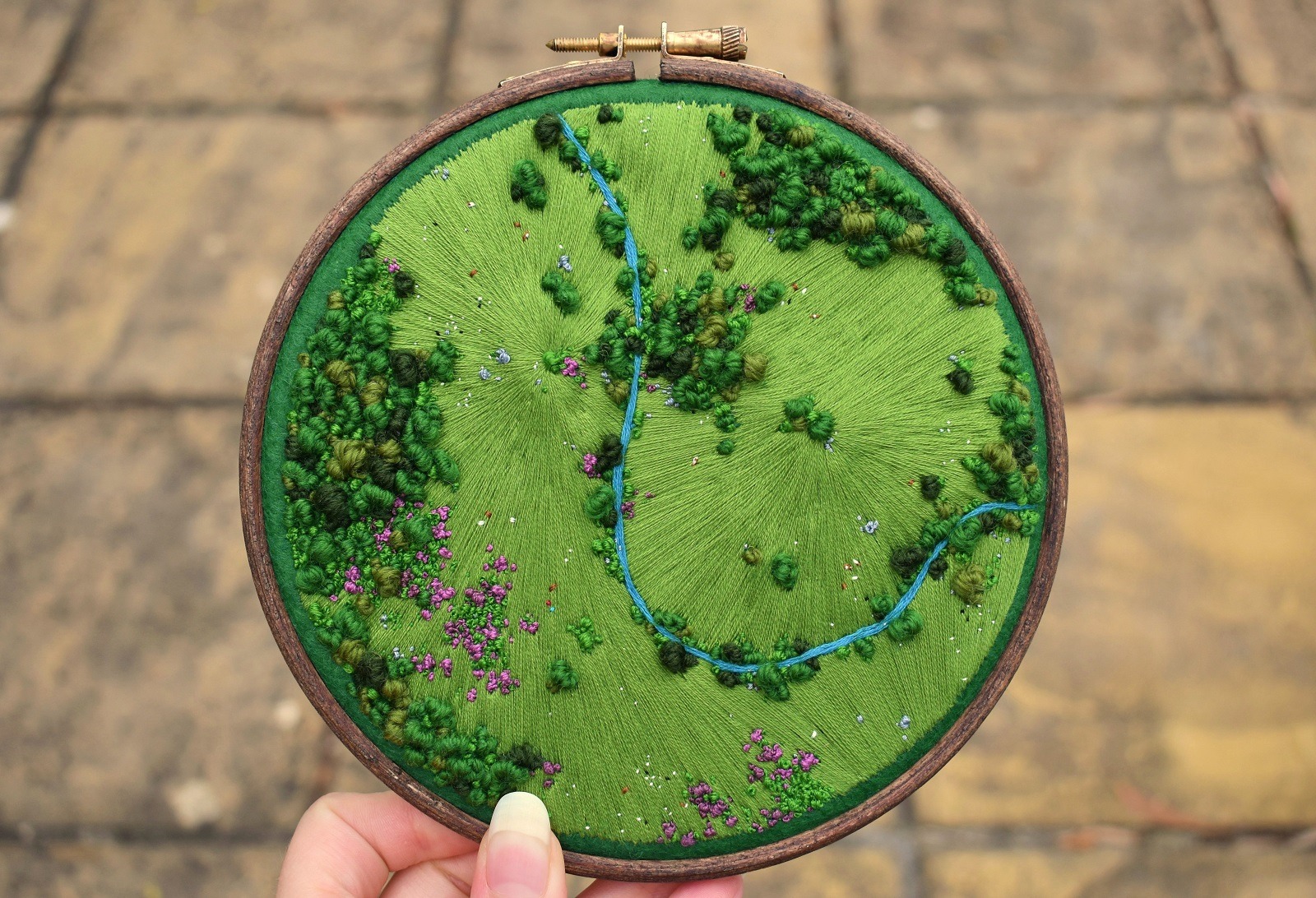
A mix of nostalgia and impressionism
Victoria Rose Richards: I have autism and as much as I want to create landscapes, I actually find mediums like painting very difficult. Autism can make certain motor and coordination actions more complicated but I find sewing very easy! I love that I can create so many different textures using cotton and wool, and create more impressionistic looks with bold lines and colours.
I have a lot of nostalgia surrounding the Devon countryside as I’ve grown up here. I try to share some of that nostalgia in my art, creating idealised scenes with bright colours.
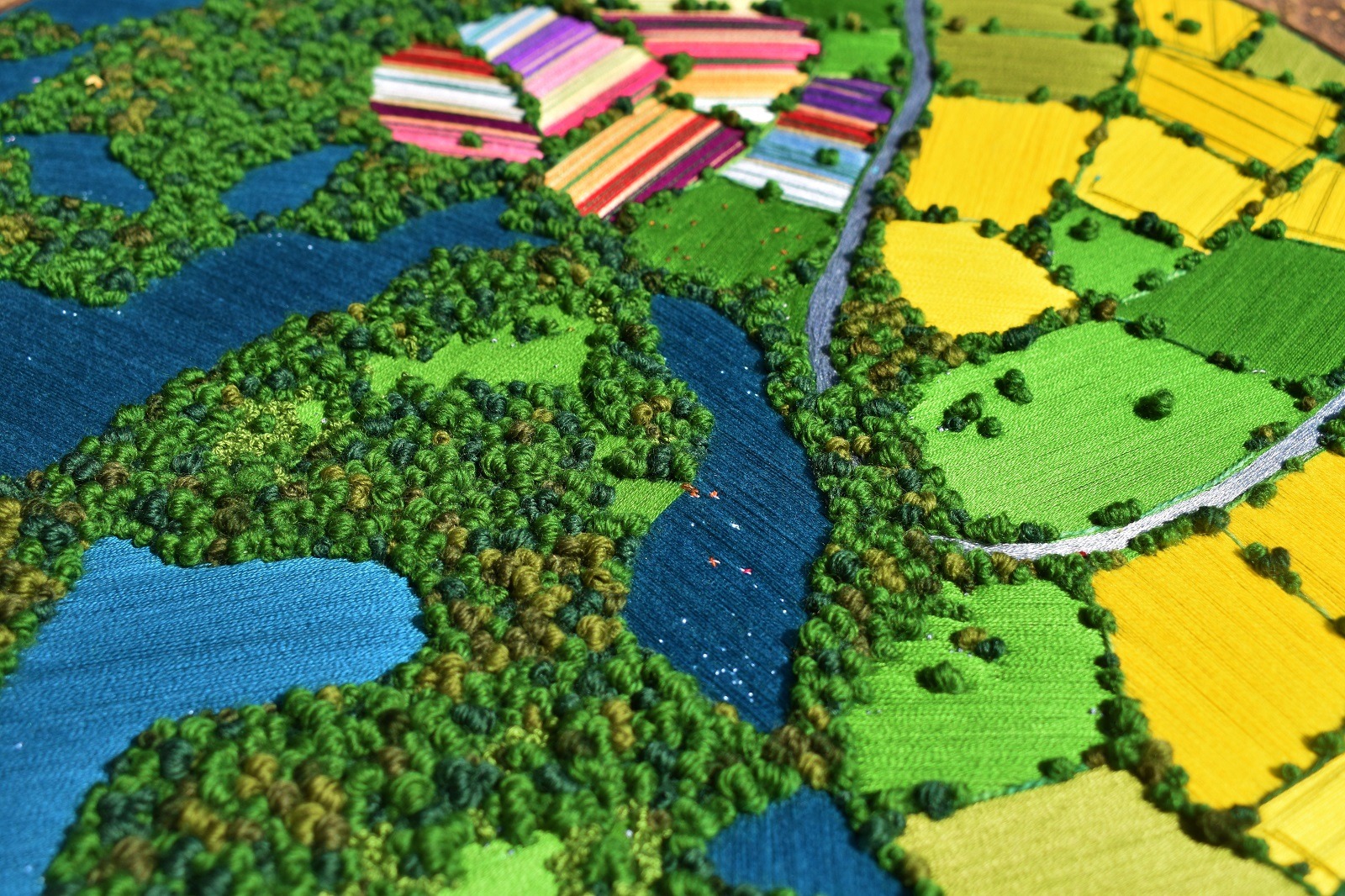
Intuitive textured stitch
I rarely plan my art pieces. What I do is make some rough lines on a felt sheet for some tree groups, start adding wool knots for them and let the shape of the landscape form around these.
For the colours, I just decide what mood I’m in! Yellow is my happy colour so I use a lot of that.
I use several stitch types to create realistic textures, like French knots for trees/bushes, satin stitch for flat fields, seed stitch for flower meadows and split stitch for roads.
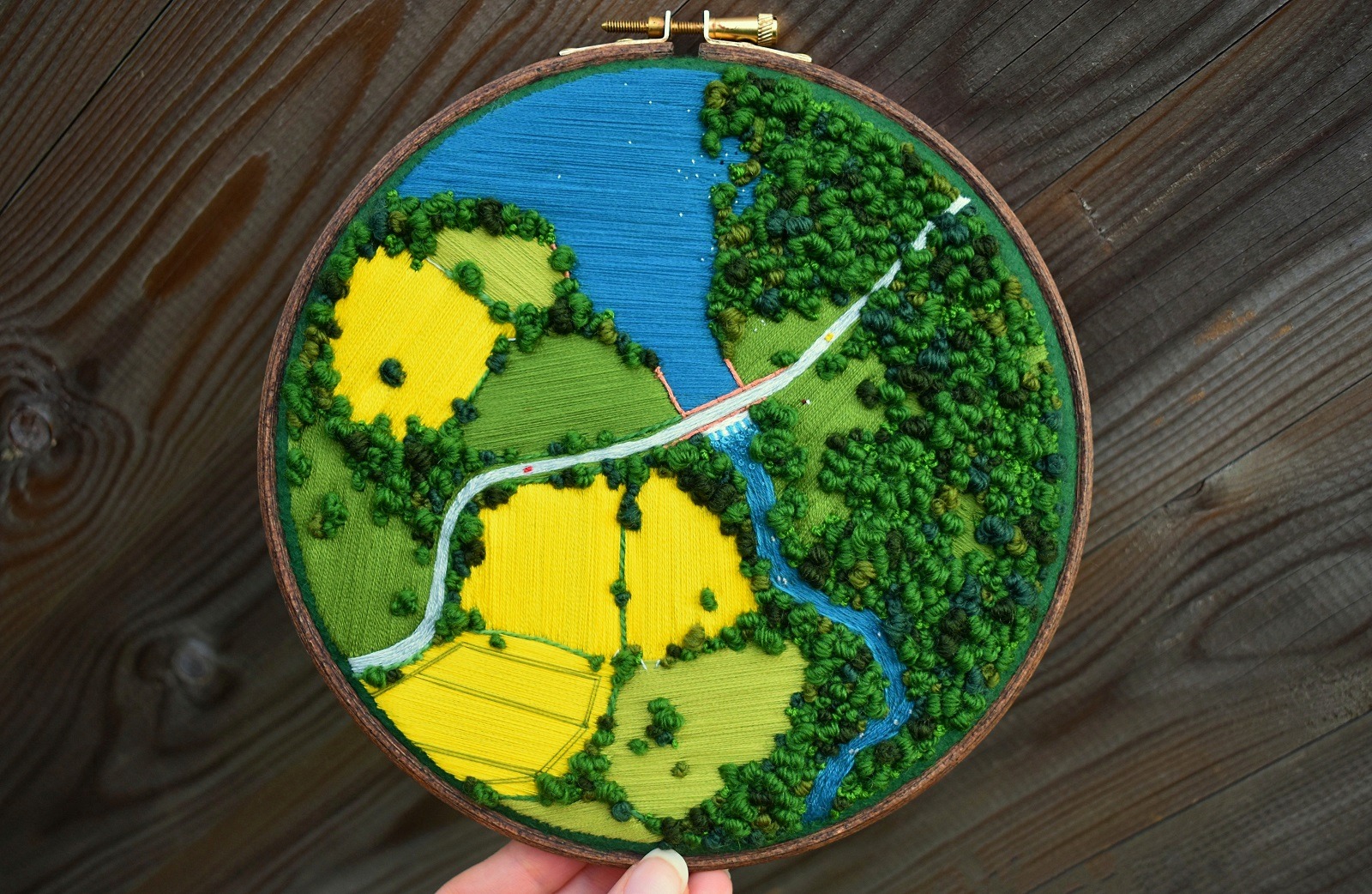
Variety is the spice of life!
My advice, for embroidered landscapes specifically, is to not be afraid of using lots of stitch techniques and thread types!
A lot of artists use the same few basic stitches like running and split stitch, but so much more texture and depth can be created when you utilise lots of stitch types. Similarly, using a variety of thread types like tapestry wool, sock wool, metal threads and ribbons can result in some amazing effects!
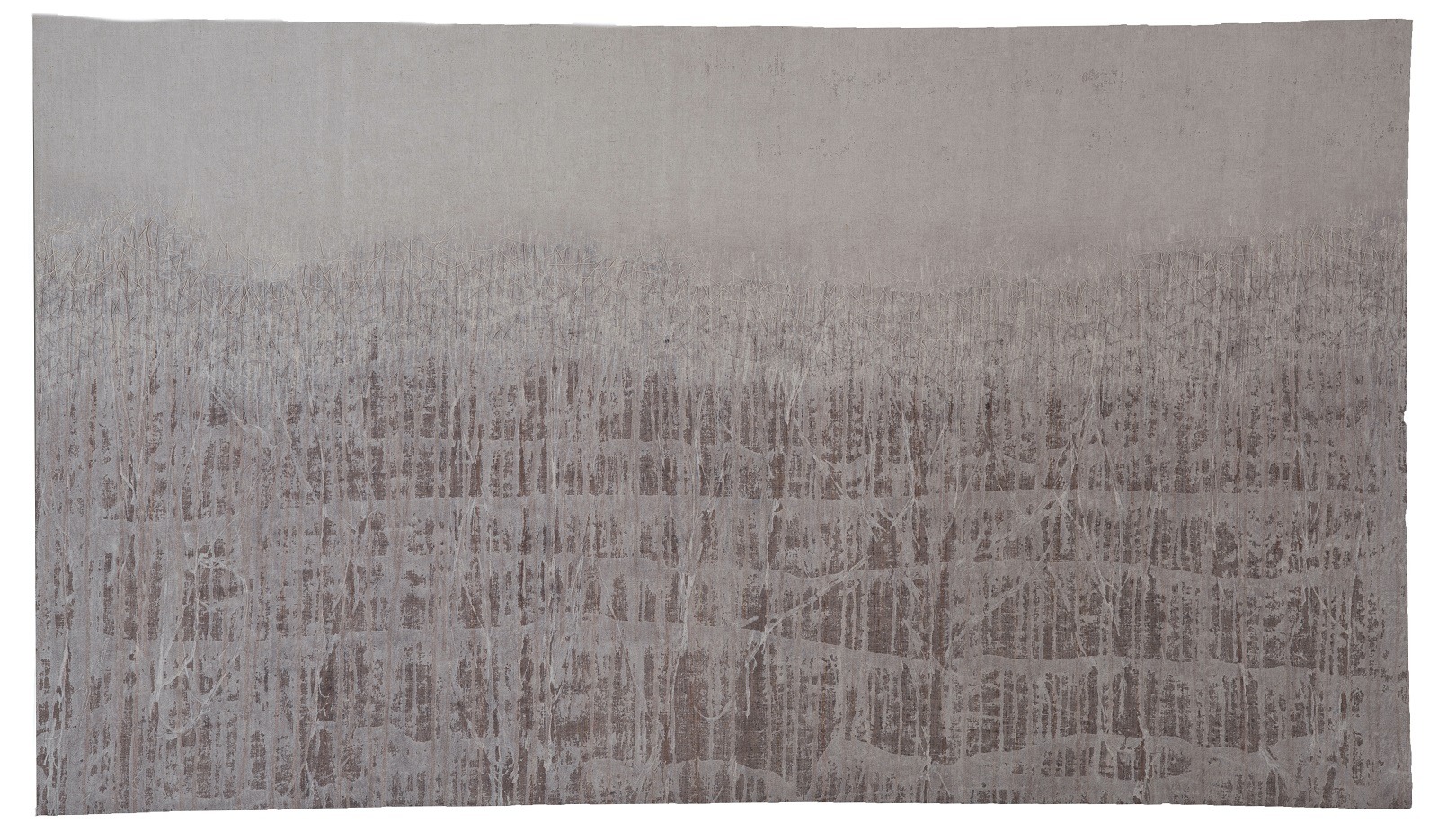
Claire Benn
Drawn by the solitude, stillness and silence of wilderness landscapes, Claire Benn’s work combines fabric, thread and pigments. Using these materials, she makes a connection with the textures of the earth, rock and snow found in these desolate places. Stitch allows her to embrace the concept of time, or timelessness while adding a tactile element to her work.
Website: www.clairebenn.com
Instagram: @HerQuietMaterials
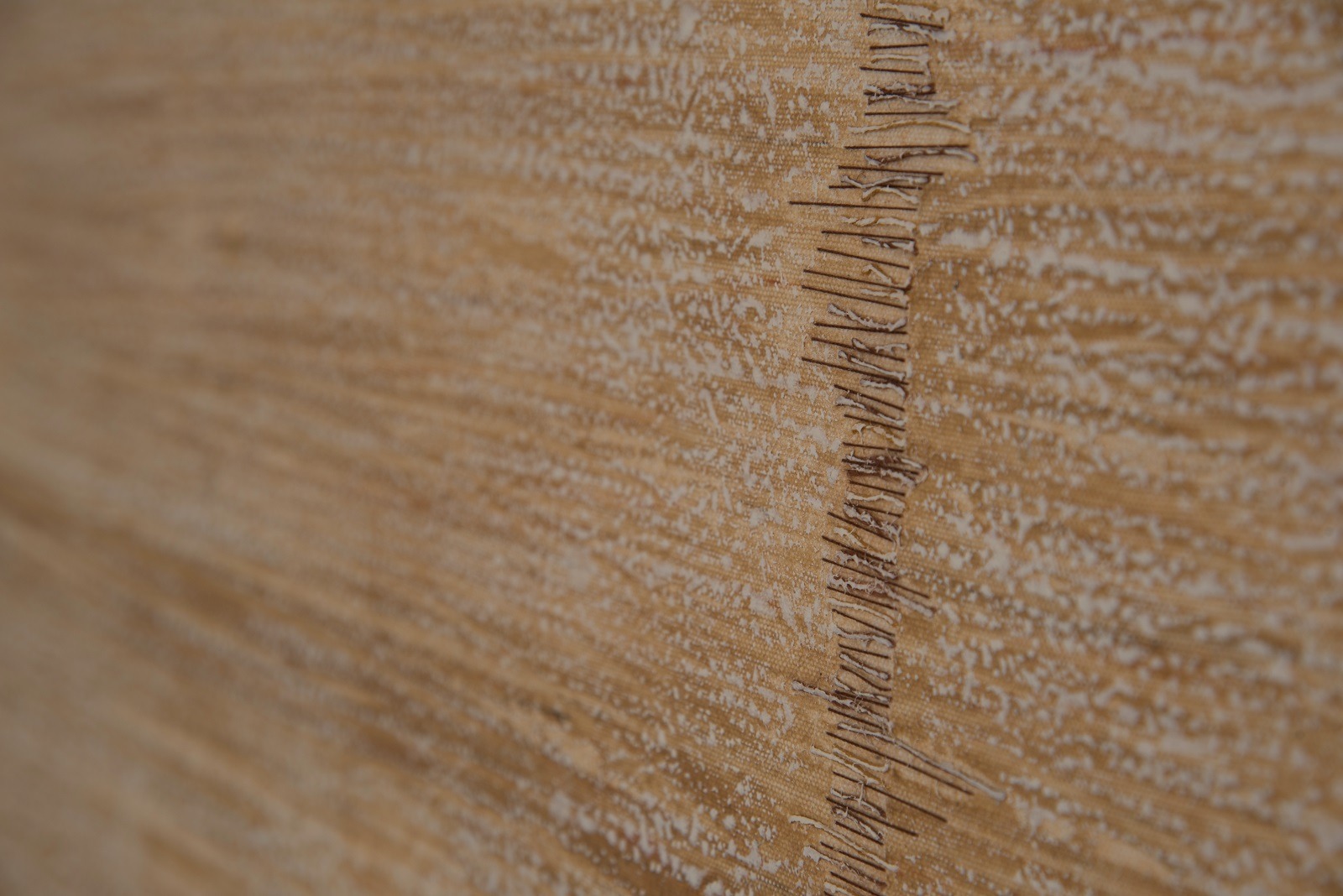
Silence and solitude
Claire Benn: Remote, desolate landscapes are primal, visceral, raw and elemental, a manifestation of the power of the natural world. These are spaces where I can let my mind roam free and simply engage in ‘being’ (not doing). I can look, wonder and feel humbled. I can look at the ‘long view’ and the horizon. I can exist in solitude, stillness and silence.
I aim for an abstract representation of the landscapes I engage with. I have no desire to faithfully or literally reproduce them. Instead, I aim to provide the viewer with an artwork they can lose themselves in and discover their own sense of quietness and stillness.
I wrote a poem about the Atacama, which is available as a recording on my website; somehow these words say it all for me.
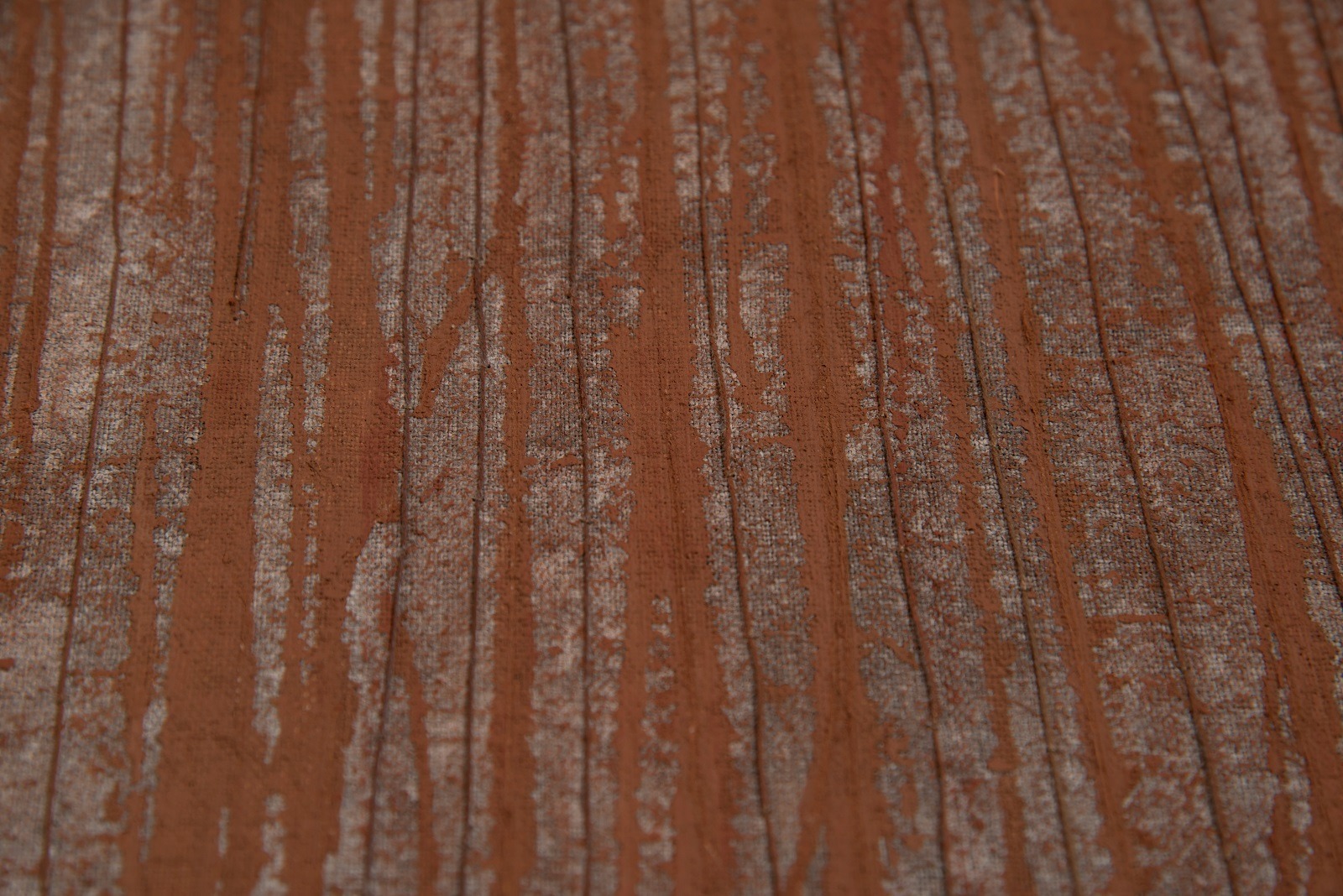
Making notes and asking questions
I’m not a keeper of sketchbooks or a taker of photographs. But I do have notebooks as I undertake a lot of writing while I’m in the landscape, and once I’ve left it. I do take a few photographs, but not that many. These are mainly for colour and mark references. I re-visit my writings many times, extracting what I need and asking myself further questions to help focus in on specific marks, lines, textures, shapes and, of course, colours.
I don’t plan the work as such, I just start with an idea and let the process lead me on. I spend a lot of time looking at the work as it progresses, often with a seemingly empty mind but ideas always float in (sooner or later) as to what I need to do next.
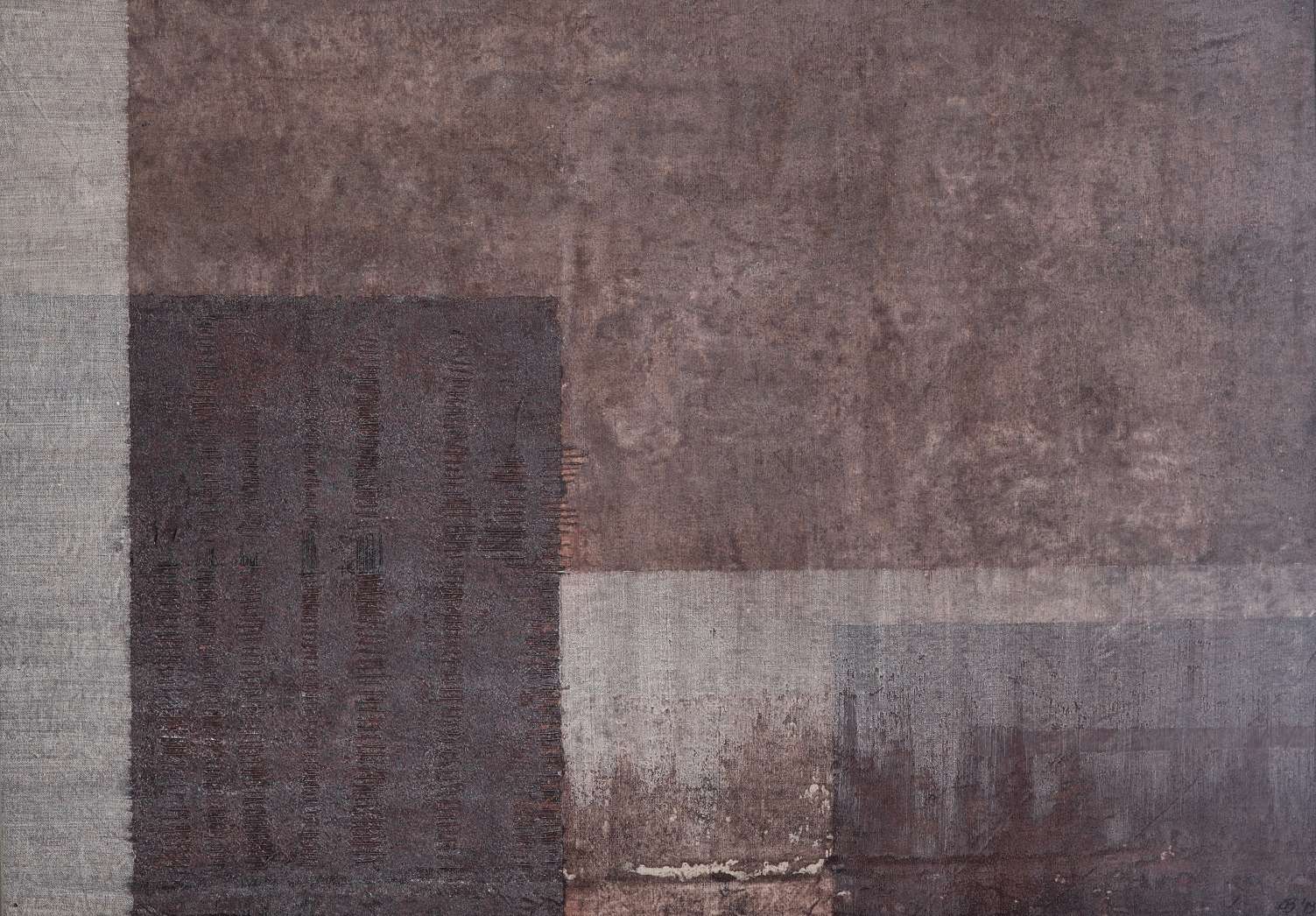
Absorb your surroundings
If you want to capture the character and atmosphere of a landscape, I have three tips:
Take the time to really, really look and absorb a sense of the place. Notice what you respond to visually and examine it closely. Observe how you’re responding spiritually and emotionally. Ask yourself: “How do I feel, in this place?” By all means take a couple of photographs but be careful you don’t become distracted by what might make a good photograph. Photographs are no substitute for observation and if you look well enough, you won’t need them.
Write about your thoughts and feelings; from words come clues you can visually translate into the work. Explore ideas that will bring the concept of your work together.
Simplify! Don’t try and ‘do it all’ in one piece of work. For me, it’s not about re-creating a sense of the landscape, or representing it faithfully. It’s about trying to evoke the feeling of the place. This might come down to some key colours, a few simple marks, or the texture. One critical element for me, is the long view, the far horizon.
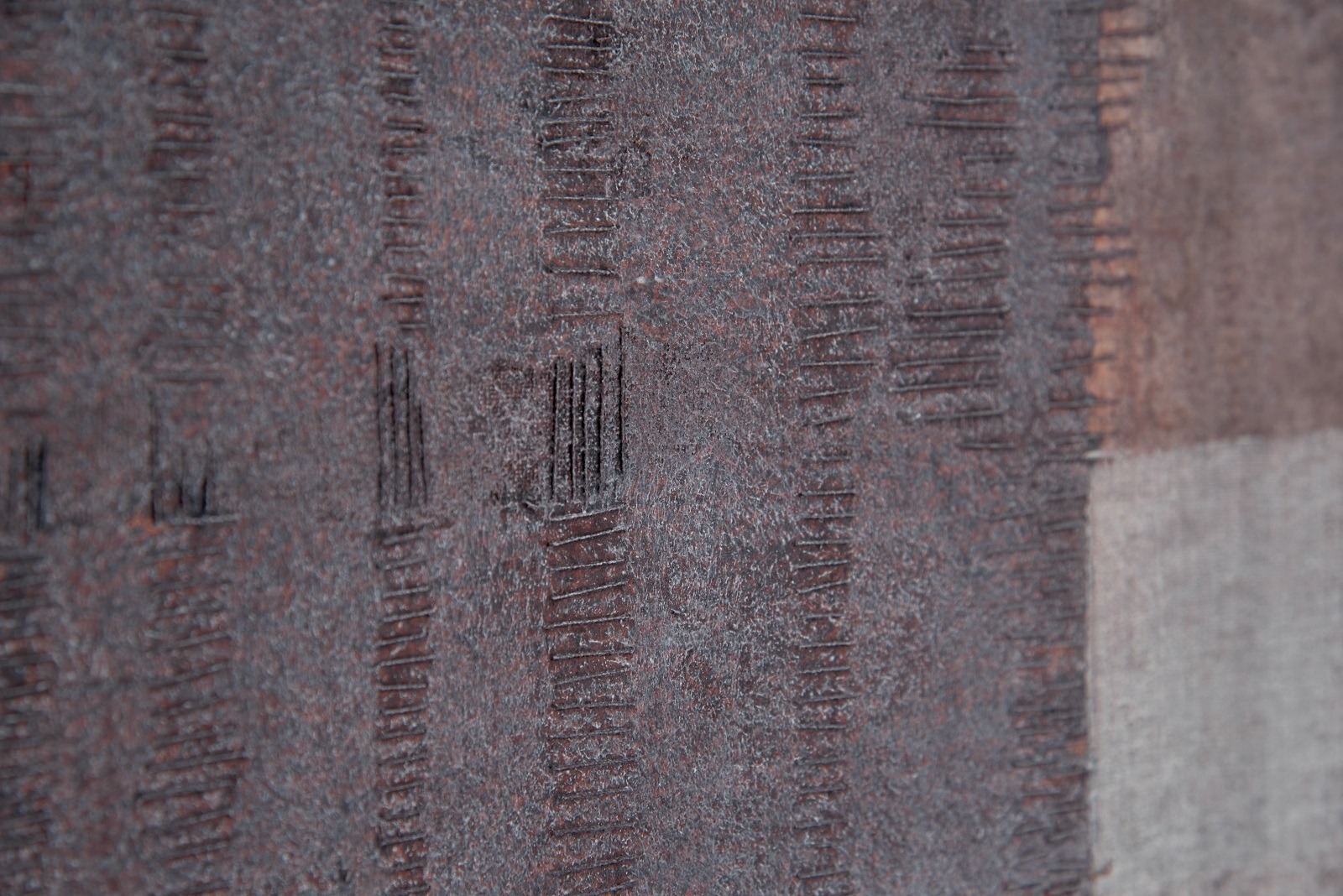
Make your own landscapes
Our fabulous featured artists have shown us some of the many ways to represent the places we feel deeply connected to. Let’s recap their top tips for making textile art landscapes.
First, select a landscape that has personal meaning. Think about how you are emotionally connected with this chosen landscape. Is it the colours or the textures? The atmosphere, the geology, or the weather? Or is it a personal connection, maybe a memory or a narrative, that links you to the place?
Now that you’ve found a landscape that inspires, it is time to observe. Look for the key characteristics of your landscape. What is it that you would like to represent? Are you looking for realism in your work, or a more idealistic outcome? Do you want to work in a more abstract way, to capture the atmosphere of the location? Perhaps you want to focus on the shapes and the texture, and capture the vibrant or earthy colours. Or you could use stitch to express the emotional impact of the place.
Now brainstorm your ideas; note everything down and collect all your ideas in one place, without judgement. This might include potential techniques and processes, materials and design ideas, as well as reference images or notes describing feelings, emotions, narratives or connections.
Think about using different approaches to achieve the depth, texture and atmosphere you are looking for. How will you evoke the feeling of the place? Try out a variety of stitch techniques, include several different threads or fabrics, or experiment with paint or collage. Find out what resonates with you. Settle on the techniques you are most passionate about and get to work creating a unique textile landscape that is personal to you.
Did this article get you thinking about how you might make your very own landscape-inspired work? If so, let us know in the comments below.
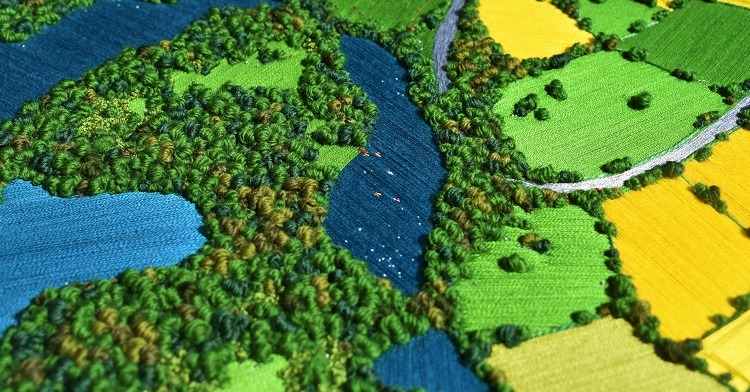

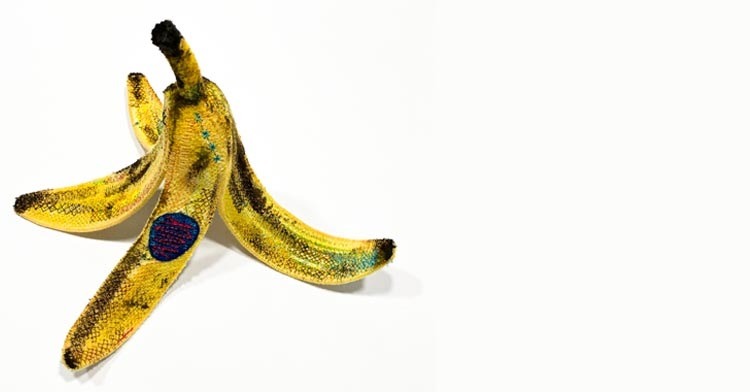
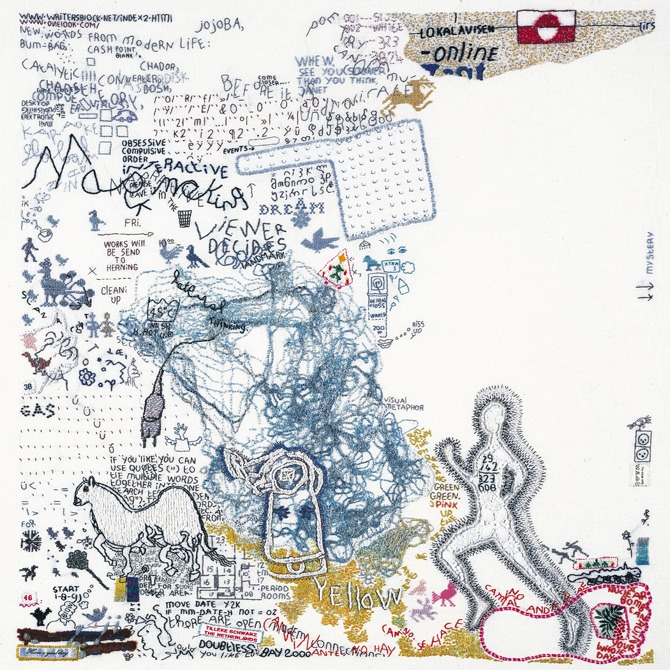
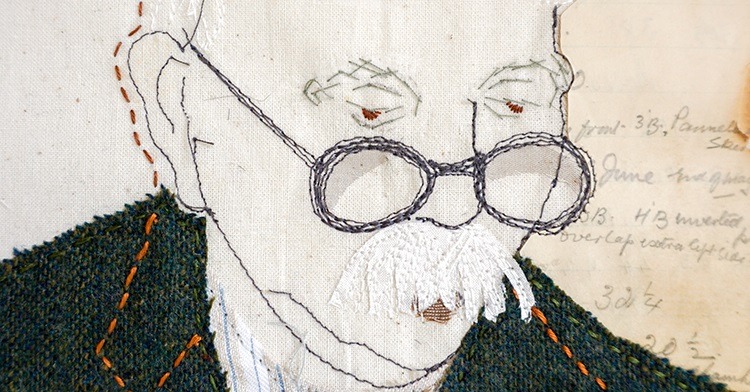
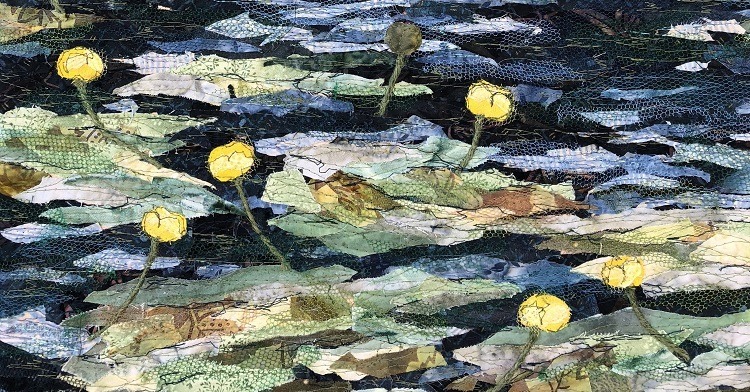
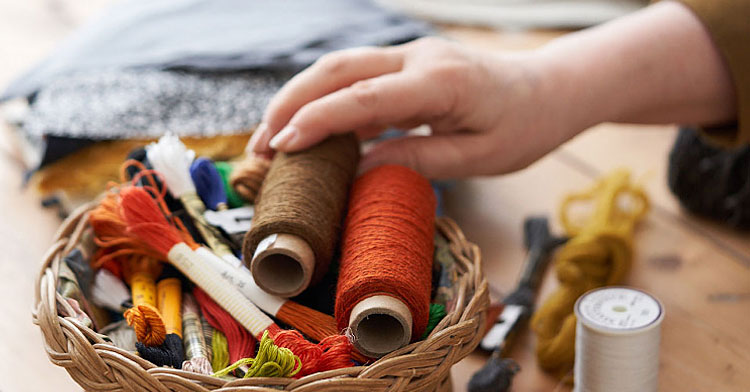
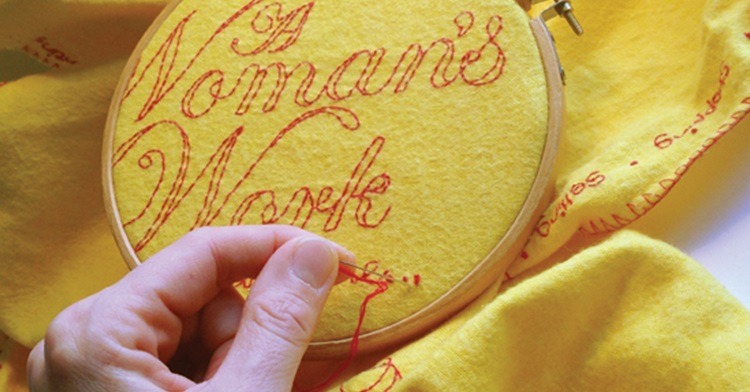
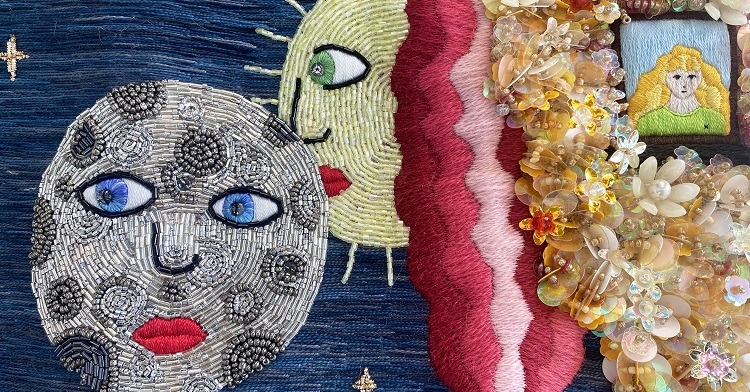
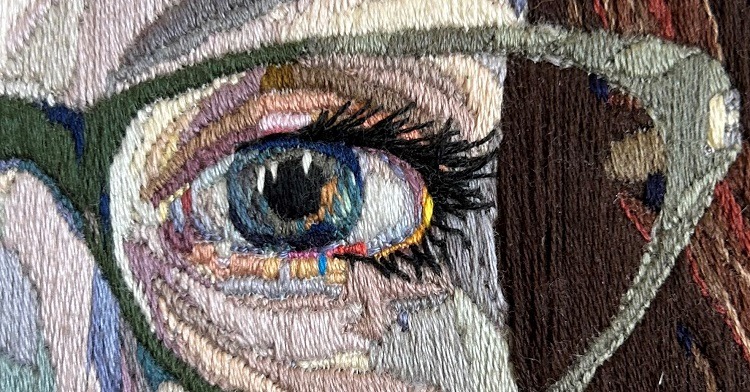
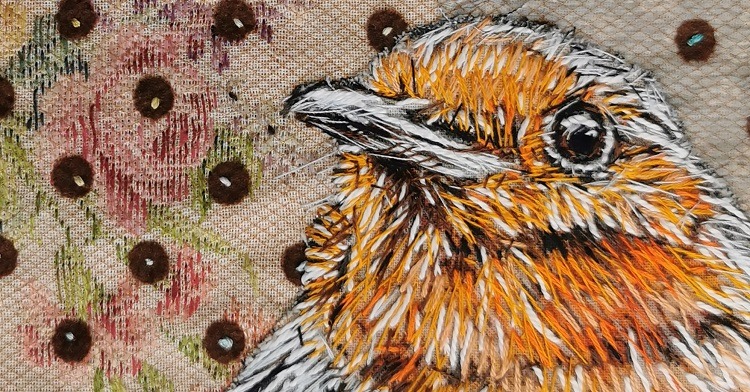
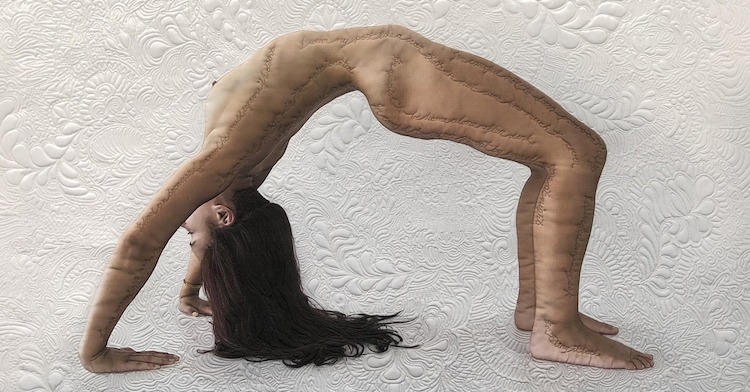
26 comments
Carolyn Bradburn
Wonderful inspiring article. Lovely to read individual artists words .cant wait to return to mt fabrics and threads .
Louise
Love this to see landscape represented!
Betsy Akins
Thank you for such an inspirational article! I connected with something in each artist interview and appreciate how I might follow up in my own efforts. Landscape and nature are universal themes, unifying us all.
Jane Dahill
This article hit my inbox about 12 hours after I started 2 new landscape stitch works after quite a fallow few weeks. It has given me lots of ideas as well as supporting the ways I was already beginning to think about creating the picture stories Thankyou.
amberley
That’s wonderful to hear, Jane. I hope the pieces are going well and it’s great you’re getting back into stitching again!
Di Secomb
So enjoyed reading this article, one of my favourites so far. Definitely some new ideas to explore. Thanks so much.
Karen Rimell
I really loved reading about the featured artists. Makes me want to create more pieces of work. Thank you Karen Rimell.
Robin
Wonderful to read of the creative talents of so many very accomplished textile artists. Thank you for educating us in such a generous way.
Ruth
I really enjoyed the variety of approaches and like others , felt inspired and encouraged
Susan J Jensen
What a wonderful newsletter, as a fibre artist who loves to create landscapes, this newsletter inspires me! Thank you so much!
Gill Stock
Fascinating article, styles I have never seen before and truly inspiring approaches to using stitches in our lives and our creations. Thank you for these great articles!
Mariam Georgaroudakis
Inspirational and energizing to read about these artist. Intrigued by the small size work to convey the landscapes. I enjoy reading this newsletter.
Anne Cameron
I found this article on landscapes incredibly inspiring. I resonate with their thoughts about the land and their techniques. Now I need to get going and experiment myself. Thank you – I found in very inspiring. Can’t wait to get going.
Janice perkin
Really enjoyed this article. Thought provoking I am doing one called rock pool at the moment and since taking Sues course I mainly use running or back stitch as it is just so versatile. So love my Monday emails!
Jan Andrews
I always enjoy the articles that you email but this one resonated with me and has given me lots to think about. Thank you.
Vikki Padgett
Such an interesting read. Thank you to the artists for so generously sharing their thought processes and tips. I particularly like the quote (advice) Jette Clover shared from Chuck Close.
Sheila Francis
What a marvellous array of textile ideas.I love to concoct landscapes of my favourite places and beginning to use multi media techniques to achieve these ends. I look forward to the next newsletter,very inspiring!
Ceri Brooks
Enjoyed this article – so good to hear how different artist’s work, what inspired them and their hints and tips.
Thank you for sharing this wonderful article.
Jana
Wonderfully creative and bold artists, all! Delightful to read their stories, where they live, and what influences them. Just makes my day to know these artists are in the world making amazing landscape art.
Sharen
As I have been working on a landscape with only stitches I found this article very helpful.
Nilda Frenkiel
Muy estimados todos: siempre miro con atención todo lo que recibo pero esta última es sensacional !!!! diría que es gran inspiradora y debería ponerme a trabajar en lo que tanto quiero y me gusta.
Sin duda esto ha sido como un knoct-out. (no sé si está bien escrito)
Además es para felicitar la cantidad de libros o revistas que tienen, son una tentación…
Les envío un gran y cariñoso abrazo
Nilda
Linda foley
Love this newsletter, really relates to how I like to create and what is important to me. Some really inspiring ideas.
thank you
Ann
A very interesting set of interviews, each view of the landscape seen with a different eye.
Maggie.millard
Just what I needed. I am tired of being told to produce sketch after sketch. My drawing is so poor it puts me off put a needle in my hand and I am in a different world. I am sure it must make things easier if you have a picture in front of you ,but it just doesn’t work for me.I am surprised at what appears sometimes when l just let loose.P aper and pencil seems so unnecessary somehow. Nice to know I am not alone. Thank you all.
Jenny gridley
I just adored the work by Victoria Rose Richards. What an inspiration! The bold dramatic colours draw you into each piece. It has really prompted me to pick up my needle and ‘just do’.
Margaret Ferguson
Thank you so much for a truely inspirational news letter. Good to hear about artists who are on “the same page”as me.